It is well known that flints or nodular cherts occur in sedimentary carbonate rocks. Most of such siliceous nodules originate from replacement of carbonate minerals by silica (Emery and Rittenberg, 1952; Rutten, 1957; Pittman, 1959; Kanmera, 1968; etc.). The origin of silica, however, has long been a controversial subject. Debate has centered on whether the silica is biogenic or of inorganic precipitation. Flints from the Douara Basin, northeast of Palmyra, Syria, throw some light on the problem, as the flints display many apparently primary sedimentary textures.
The marl and limestone of the Douara Basin are dense and commonly foraminiferous. They are sometimes silicified and phosphotized, and contain abundant flints and barite nodules in some horizons of the thick sequence (Soulidi-Kondratiev, 1966). The flints, forming nodules or relatively thin beaded bands, were used as stone wares. In this paper, the flints are described and the possible carbonate-silica replacement origin of flints is discussed.
STUDY METHODS
The study is divided into three parts: a conventional petrographic examination of thin sections to observe the constituent minerals and the textures of the flints; X-ray diffraction and chemical analyses for bulk rock mineralogy and chemistry; and scanning electorn microscope observations. The last attempt was made to investigate the primary features expected to be preserved in the flints rather than the secondary mineralogical features or textures by recrystallization, as scanning electron microscopy is very useful in observing morphological features of constituent materials of other siliceous sedimentary rocks (Imoto and Saito, 1973; Tiba, Matsubara and Saito, 1976).
MATERIAL
The flints studied are mostly lens-formed nodules approximately 20 cm in diameter and 10 cm in thickness. They have a dense and subvitreous appearance but vary in color. The commonest color is light brown to brown, and, in relatively larger blocks of the flints, dark brown or black. The rough crust, a few centimeters thick, is white or light-colored. To the naked eye, some flints may often be mistaken for bedded chert or obsidian because of their subvitreous luster and subconcoidal fracture.
PBA-1 (Fig. 1. a): A fragment of nodule with a 2 mm thick crust and light
brown gritty surface. The inner part shows a milky cocoa color, vitreous luster,
and uneven angular fracture relief.

PBA-2 (Fig. 1. b): A lens-formed nodule with a light gray crust of 1-1.5 cm thickness. The surface of the crust is gritty to the touch. The inner part is light cocoa in color and of unglazed porcelain luster. The part closer to the crust is rather dark.
PB-35 (Fig. 1. c): A nodule with a 1-3 mm thick crust. The surface of the crust is subgritty. The boundary between the crust and the inner part is often indistinct. The inner part is further subdivided into the outer raw amber portion and the inner black portion. The boundary between the two is irregular and gradual. Both portions show a subvitreous luster and concoidal fracture similar to obsidians.
THIN SECTION STUDY
In thin sections, the flints are light to medium brown translucent chert
consisting of fine-grained equidimensional quartz and chalcedonic quartz with
minor amounts of carbonate (?) minerals. Abundant foraminiferal pseudomorphs
are scattered (Photos 1-1a, 1-2a, 2-1a and 2-2a). Although the foraminiferal
tests are replaced and their cavities are filled with silica, the forms of
those microfossils seem to be well preserved in the flints (Fig. 2). It is
suggested that the foraminiferal tests did not dissolve until silica precipitated
in their cavities and in cementing groundmass and that the replace ment of
carbonate by silica progressed gradually. The foraminiferal shells consist
of cryptocrystalline to micro crystalline quartz, which is indistinguishable
from the sur rounding cement material. The material filling the foraminiferal
pore spaces is mostly coarser-grained, colorless chalcedonic quartz (Photos
1-1b, 1-2b, 2-lb, and 2-2b). Siliceous sponge spicules are also common in
the flints as aggregates of colorless cryp tocrystalline quartz but such fine
textures as central canals of spicules are not preserved. Some flints contain
rhombohedral crystals of carbonate in appreciable amounts. Opaque minerals
such as pyrite and its weathering products are common minor constituents of
the flints.

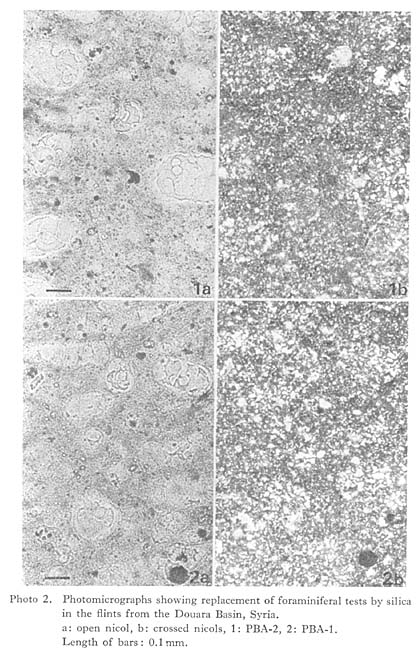
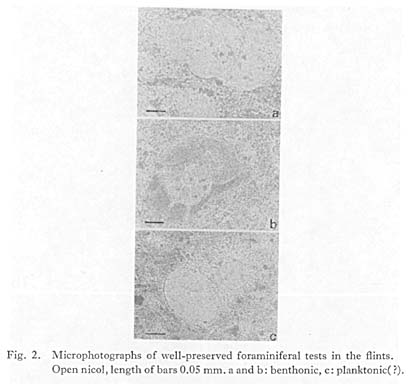
PBA-1 (Photos 2-2a and 2-2b): Foraminiferal shells, 0.05 to 0.3 mm in diameter, constitute less than 50% in volume of the bulk rock. The foraminiferal cavities consist mainly of radial aggregates of fibrous chalcedonic quartz, whose grains are coarser than those of the enclosing microcrystalline quartz in the matrix. The tests of foram-inifers are replaced by fine-grained fibrous chalcedonic quartz growing approximately perpendicularly to the inner or outer walls of the tests. Refractive indices of those quartz crystals are higher in the test than in the cavities. Chalcedonic fibers are length fast. The microcrystalline matrix consisting of more than 50% in volume of the bulk rock contains abundant spicules less than 0.2 mm in length. Network veins of quartz often cut the foraminifers. Opaque mineral (possibly pyrite) is also present.
PBA-2 (Photos 2-1a and 2-1b): This specimen contains smaller amounts of forami nifers than the specimen PBA-1. The foraminiferal cavities are filled with chalcedonic quartz or with material of light-brown color in plain light but no double refraction. Other features are similar to those of the specimen PBA-1 excluding the absence of quartz veins.
PB-35 (Photo 1): The foraminiferal cavities are filled not only with clear chalcedonic quartz but also with brown translucent or opaque materials. In the enclosing matrix of microcrystalline quartz are apatite-like grains less than 0.15 mm long. Abundant spicules are contained. The other features are similar to PBA-1 and PBA-2.
SCANNING ELECTRON MICROSCOPY
Before examination with the scanning electron microscope, all the specimens of the flints were etched by a solution of 10 to 20% hydrofluoric acid, then washed with running water and cleaned by means of ultrasonic vibration to remove dusty materialson the etched surfaces. The etched chips "were coated with gold in a vacuum, evaporator, and then examined.
Observation under the scanning electron microscope distinctly shows that
the flints from the Douara Basin consist mainly of silicified foraminifers,
apines or spicules, and their fragments (Photos 3-1 and 3-2). The spicules
seem to be arranged with preferred orientation (Photo 3-2). Such texture probably
reflects a condition at the time of deposition. The matrix exclusive of the
foraminiferal tests is composed of spicules, fragments of the tests, and spongy
microcrystalline quartz (Photos 3-3 and 3-4). The magnified spongy parts show
that the finer matrix is also of biogenic origin. Many microfossils, such
as fine spicules with overgrowth by recrystallization (Photos 4-1 and 4-2),
coccoliths replaced by silica (Photos 4-1 and 4-3), and an unidentified one
(Photo 4-4), can be obviously recognized. These facts indicate that the constituent
material of the flints deposited is an ill-sorted mixture of calcareous and
siliceous microfossils. The flints are, therefore, not the products of inorganic
precipitation of silica during deposition, but are the products of epigenetic
replacement by silica.

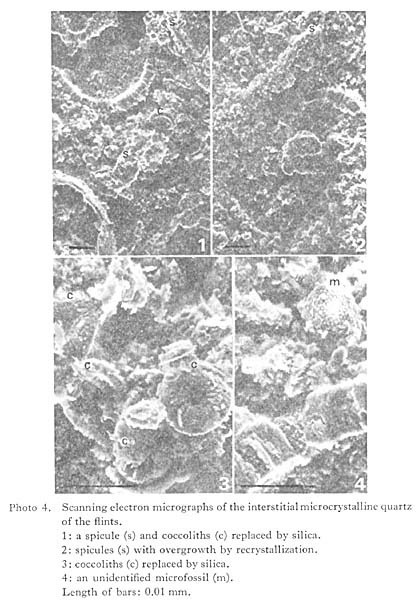
Chalcedonic quartz filling a foraminiferal cavity and a part of a foraminiferal
test replaced by cryptocrystalline quartz are shown in Fig. 3. The chalcedonic
quartz seems to grow from the test wall toward the center of the cavity (Fig.
3. a). This may mean that the foraminiferal pore space had not yet been filled
with fine-grained clastic material at the time of deposition. In the foraminiferal
test, most of the very fine-grained quartz crystals are xenomorphic (Fig.
3. b). The irregular forms and the fine size of the crystals may support relatively
slow and gradual dissolution of calcite tests and concomitant precipitation
of silica. Rapid dissoltion of the tests would have formed relatively wide
pore space, where larger crystals may be able to precipitate.

X-RAY POWDER DIFFRACTION DATA
The bulk rock samples of the flints examined here consist almost entirely of quartz, in some cases with minor amounts of carbonate minerals. These results are not contradictory to those of the conventional petrographic study. The absence of distict patterns of carbonate minerals in X-ray diffraction analyses suggests that rhombohedral crystals observed in thin sections are pseudomorphs of original constituent minerals.
CHEMICAL ANALYSES
Two bulk rock samples were chemically analyzed (Table 1). In spite of differences
in appearance (color, luster, fracture etc), these flints have quite similar
compositions with only significant differences in SiO2 and H2O+
contents. The flints with obsidianlike appearance in which foraminifers are
ill-preserved (PB-35) are richer in SiO2 and poorer in H2O+
than the chert-like ones (PBA-1), though very high SiO2 content
is common to both. Lack of Al2O3 and MgO means that
these flints do not contain clay minerals in appreciable amounts. This is
consistent with the absence of clay minerals confirmed by petrographic and
X-ray studies and suggests that terrigenous materials had not been introduced
at the time of formation of these flints. From these analyses, it is inferred
that these flints are composed mainly of quartz with subordinate iron oxides
and/or iron hydroxides and accessory apatite.
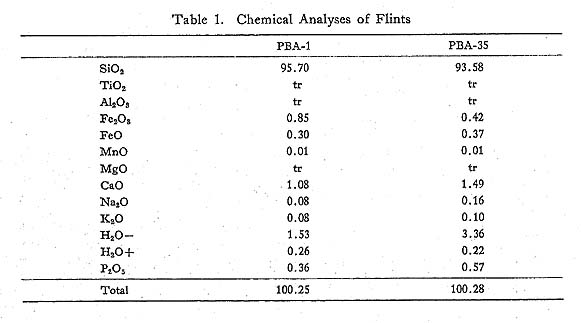
REPLACEMENT OF CARBONATE BY SILICA
Silica replacement of carbonate sedimentary rocks has been asserted on the basis of the presence of carbonate rhombs as remnants of host rocks, pseudomorphs of carbonate minerals within chert nodules, partial silicification of fossils across the boundary between carbonate and chert, and the persistence of textures such as laminations through chert nodules. The flints or nodular cherts from the Douara Basin, Syria, give direct evidence of a replacement origin. They consist of chalcedonic quartz and microcrystalline quartz. No calcite and dolomite are found and detrital material such as quartz, feldspar and clay minerals, is also absent. Most flints, however, contain abundant foraminiferal shells consisting of chalcedonic quartz. Pseudomorphs of coccoliths are also confirmed in the enclosing matrix of micro crystalline quartz. Such silicified foraminifers and coccoliths show that their original carbonate material was replaced by silica after deposition.
SILICA SOURCE
According to the geochemical studies, precipitation of silica from sea water is almost impossible by inorganic means because of its low concentration, so organic agents are the most likely source of silica precipitation (Correns, 1950; Degens and Epstein, 1962; Krauskopf, 1956, 1959; Siever, 1957). The presence of abundant siliceous spicules in the flints from the Douara Basin is a key to the solution of the problem of the silica source. Any silica supply of volcanic or hydrothermal and other inorganic origin cannot be expected in the Douara Basin.
In these flints, the original silica has been concentrated by organisms,
in particular siliceous sponges, and has deposited, with abundant foraminifers,
coccoliths and other carbonate materials (Fig. 4. a). The siliceous sponge
spicules composed of low crystallized silica were buried and dissolved with
increasing temperature and pH in the solution trapped in the sediments (Krauskopf,
1956, 1959; Okamoto et al., 1957; Siever, 1957). Provided that dissolution
of sponge spicules is promoted, sponge spicules must be preserved only partly
or consumed entirely. There are, however, abundant minute sponge spicules
in these flints. It is probable that only the peripheries of the sponge spicules
were dissolved into solution and their main parts were left undissolved. This
may be attributed to the pressure solution effect as in the case of quartzose
sandstone (Thompson, 1959). Vast number of sponge spicules could have supplied
considerable amount of silica sufficient to replace foraminifers and coccoliths.
A decrease of pH has caused solution of the carbonate materials and precipitation
of silica side by side. Carbonates were lost from the area under Such conditions.
Eventually the free pore space of foraminiferal cavities and the matrix were
filled with silica (Fig. 4. b). Formation of chalcedony fibers coarser than
those of microcrystalline matrix was possible only in the larger free space
of foraminiferal cavities. The solution and precipitation of silica in pore
spaces must have resulted in a reduction in porosity and bulk volume. The
wellpreserved foraminiferal pseudomorphs and their fine-grained xenomorphic
quartz crystals probably imply a slow and gradual process of replacement.
Abundant chalcedony overgrowth on spicules suggests that there were both pore
spaces and the silicasaturated intersticial solution. The amorphous silica
filling the pore spaces has been turned into chalcedonic and microcrystalline
quartz through diagenesis (Fig. 4. c).
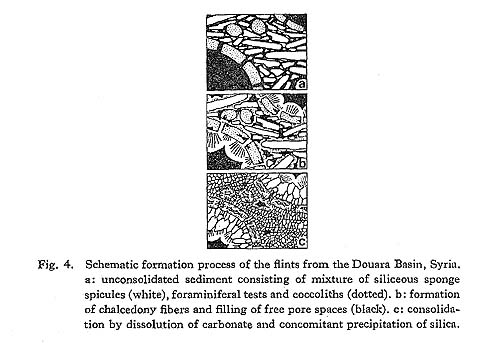
Acknowledgments
The authors are indebted to Mr. T. Akazawa, Department of Anthropology, National Science Museum, for providing flint samples, and to Drs. M. Hashimoto, A. Kato, Y. Kuwano, and S. Matsubara, Department of Geology of the same Museum, for their help in preparing the paper and X-ray diffraction analyses of flints.
LITERATURE CITED
- Oorrens, C. W. (1950)
- Zur Geochemie der Diagenese. Geochim. et Cosmochim. Acta, 1(1): 49-54.
- Degens, E. T. and Epstein, S. (1962)
- Relationship between O18/O16 Ratios in Coexisting Carbonates, Cherts, and Diatomites. Amer. Assoc. Petroleum Geologists Bull., 46(4): 534-542.
- Emery, K. O. and Rittenberg, S. C. (1952)
- Early Diagenesis of California Basin Sediments in Relation to Origin of Oil. Ibid., 36 (5): 735-806.
- Imoto, N. and Saito, Y. (1973)
- Scanning Electron Microscopy of Chert. Bull. Natn. Sci. Mus., 16(2): 397-400.
- Kanmera, K. (1968)
- On Some Sedimentary Rocks Associated with Geosynclinal Volcanic Rocks, Mem. Geol. Soc. Japan, (I): 23-32 (in Japanese).
- Krauskopf, K. B, (1956)
- Dissolution and Precipitation of Silica at Low Temperature. Geochim. et Cosmochim. Acta, 10(1); 1-26.
- Krauskopf, K. B. (1959)
- The Geochemistry of Silica in Sedimentary Environments. Soc. Econ. Paleontologists and Mineralogists, Spec. Pub., (7): 4-19.
- Okamoto, G., Okura, T., and Goto, K. (1957)
- Properties of Silica in Water. Geochim. et Cosmochim. Acta, 12 (I): 123-132.
- Pittman, J. S. (1959)
- Silica in Edwards Limestone, Travis County, Texas. Soc. Econ. Paleontologists and Mineralogists, Spec. Pub., (7): 121-134.
- Rutten, M. G. (1957)
- Remarks on the Genesis of Flints. Amer. Jour. Sci., 255(6): 432-439.
- Siever, R. (1957)
- The Silica Budget in the Sedimentary Cycle. Amer. Mineralogist, 42 (11 &12): 821-841.
- Soulidi-Kondratiev, E. D. (Compiled) (1966)
- Explanatory Notes of the Geological Map of Syria. Sheet J-37-XV (Tudmor). Dept. Geol. Mineral Research, Syrian Arab Republic.
- Thompson, A. (1959)
- Pressure Solution and Porosity. Soc. Econ. Paleontologists and Mineralogists, Spec. Pub., (7): 92-110.
- Tiba, T., Matsubara, S., and Saito, Y. (1976)
- Nodular Diatomite from Dogo, Oki Islands. Bull. Natn. Sci. Mus., Ser. C (Geol.), 2(1): 67-70.